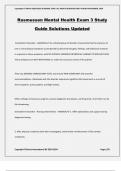Copyright © KAYLIN 2024/2025 ACADEMIC YEAR. ALL RIGHTS RESERVED FIRST PUBLISH NOVEMBER, 2024
Rasmussen Mental Health Exam 3 Study
Guide Solutions Updated
Somatoform Disorders - ANSWER✔✔-An umbrella group of disorders characterized by the presence of
one or more physical symptoms accompanied by abnormal thoughts, feelings, and behavioral reactions
in response to these symptoms, with NO PHYSICAL FINDINGS OR MEDICAL ILLNESSES TO EXPLAIN THEM.
These symptoms are NOT INTENTIONAL or under the conscious control of the patient.
They may DEMAND UNNECESSARY TESTS, and may be NON-COMPLIANT with provider
recommendations. Individuals with this disorder experience significant life impairment as a result of
their symptoms, preoccupation, and high anxiety.
Often undergo unnecessary surgeries, invasive diagnostic procedures, and drug trials, all of which can be
life-threatening.
Somatoform Disorders - Nursing interventions - ANSWER✔✔-1. Offer explanations and support during
diagnostic testing.
2. After physical complaints have been investigated, avoid further reinforcement of the somatic
complaints.
Copyright ©Stuvia International BV 2010-2024 Page 1/55
,Copyright © KAYLIN 2024/2025 ACADEMIC YEAR. ALL RIGHTS RESERVED FIRST PUBLISH NOVEMBER, 2024
3. Spend time with the patient at times other than when he/she is expressing a physical complaint (e.g.,
when talking about a pet or TV program and give the "reward" of extra attention during those times).
4. Observe and record frequency and intensity of somatic symptoms.
5. DO NOT imply that symptoms are not real.
6. Shift focus from somatic complaints to feelings or to neutral topics.
7. ******Assess secondary gains that physical illness provides for patient, such as attention, lack of work
responsibility, or guilt of a spouse causing them to stay rather than leave the patient.
8. Use straightforward approach to patient exhibiting resistance or covert anger.
9. Have patient direct all requests to a designated nurse or clinician.
10. Show concern for patient, but avoid fostering dependency needs.
11. Reinforce patient's strengths and problem-solving abilities.
Copyright ©Stuvia International BV 2010-2024 Page 2/55
,Copyright © KAYLIN 2024/2025 ACADEMIC YEAR. ALL RIGHTS RESERVED FIRST PUBLISH NOVEMBER, 2024
12. Teach assertive communication skills and techniques.
13. Teach patient stress reduction techniques, such as meditation, relaxation, and mild physical exercise.
Important thing to remember regarding the assessment of a patient with somatoform disorder -
ANSWER✔✔-When patients complain of physical symptoms, TAKE THE SYMPTOMS SERIOUSLY. Even if a
medical explanation is not found understandable, the symptoms are real and distressing to the patient.
Working with people who have somatic symptom disorders can be frustrating, and you and other staff
may find yourself avoiding interaction with them. However, when people feel they are receiving care and
attention, the intensity of symptoms tends to diminish. As the symptoms are alleviated and **RAPPORT
IS ESTABLISHED, it becomes easier to address emotional issues.
Secondary Gains - ANSWER✔✔-Benefits that a person might be receiving from the symptoms they are
having.
Example: the patient is not able to perform the usual family, work, and social functions, and receives
extra attention from loved ones.
If a patient derives personal benefit from the symptoms, relinquishing the symptoms is more difficult.
Copyright ©Stuvia International BV 2010-2024 Page 3/55
, Copyright © KAYLIN 2024/2025 ACADEMIC YEAR. ALL RIGHTS RESERVED FIRST PUBLISH NOVEMBER, 2024
Hypochondriasis (Illness Anxiety Disorder) - ANSWER✔✔-Preoccupied with having or eventually
developing a serious illness. Patients with this disorder may or may not present with somatic symptoms,
and if they do, the symptoms are usually mild.
What they do exhibit is a high level of anxiety and alarm about their health lasting at least 6 months, and
may either excessively check for problems or avoid medical care. It is important to consider other
possible diagnoses such as anxiety disorders.
They are more alarmed by the potential implications of any disorder than with the disorder itself, and
are alarmed with any new bodily sensations. Patients can misinterpret normal physical sensations such
as sweating, abdominal cramping, or awareness of heartbeat as indicative of disease.
Conversion Disorder - ANSWER✔✔-Disorder that presents with one or more symptoms of impaired
motor or sensory function. The deficit causes significant distress to the patient and impaired social or
occupational functioning.
Symptoms include weakness or paralysis, abnormal movement, swallowing or speech difficulties,
seizures or attacks, sensory loss or anesthesia, or symptoms involving the senses (blindness or loss of
smell).
Nursing Interventions for Conversion Disorder - ANSWER✔✔-Use a straight forward approach
Be supportive, yet ASSERTIVE with them
Copyright ©Stuvia International BV 2010-2024 Page 4/55




